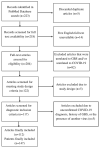Concomitant Guillain-Barré Syndrome and COVID-19: A Meta-Analysis of Cases
- PMID: 36557036
- PMCID: PMC9788175
- DOI: 10.3390/medicina58121835
Concomitant Guillain-Barré Syndrome and COVID-19: A Meta-Analysis of Cases
Abstract
Background and Objectives: Recent findings demonstrate that the transmigration of severe acute respiratory syndrome Coronavirus 2 (SARS-CoV-2) to the nervous system implicates severe neurotropic pathologies, including the onset of the rare disease called Guillain-Barré syndrome (GBS) which is characterized by immune-mediated polyneuropathy. This study aimed to identify the predisposing factors and the clinical features of coronavirus disease 2019 (COVID-19)-induced GBS. Materials and Methods: We have performed an analysis of 147 cases. A systematic review of the published research work was performed per the PRISMA statement to obtain individual participant data (IPD) for the meta-analysis. The search was conducted through PubMed, using the combined search terms "Guillain-Barré syndrome" and "COVID-19". All case reports and series in the English language with accessed full text were included in the search. Results: A systematic database search led to the retrieval of 112 peer-reviewed articles published between 1 April 2020, and 8 February 2022. The articles comprised 16 case series and 96 case reports containing IPD for 147 patients. Our findings showed that 77.6% of all cases were 40 years or older. Males comprised most of the cases (65.3%; n = 96). The intensive care unit (ICU) admission was 44.9%, and the need for mechanical ventilation (MV) was 38.1%. The patients presented with hyporeflexia or areflexia (84.4%; n = 124), lower limb strength and sensation impairment (93.2%; n = 138), upper limb strength and sensation impairment (85.7; n = 126), and somatic sensation impairment (72.8%; n = 107). The patients presented with increased cerebral spinal fluid (CSF) protein levels (92%; n = 92) and the presence of CSF albuminocytological dissociation (83.5%; n = 71). The most common variant of GBS observed was acute inflammatory demyelinating polyneuropathy (AIDP). We found that predisposing factors concomitant with COVID-19 and GBS were male gender and older age. Among the cases, patient mortality was 10.9%. Conclusions: A gap of knowledge exists regarding the complete spectrum of clinical characteristics of COVID-19-related GBS. Recent findings suggest that SARS-CoV-2 triggers GBS, as it follows a similar para-infectious pattern as the other viral agents contributing to the onset of GBS.
Keywords: COVID-19; GBS; Guillain–Barré syndrome; SARS-CoV-2; meta-analysis; neurological complications.
Conflict of interest statement
The authors declare no conflict of interest.
Figures
Similar articles
-
Guillain-Barré syndrome after COVID-19 vaccination: A systematic review and analysis of case reports.Clin Neurol Neurosurg. 2024 Mar;238:108183. doi: 10.1016/j.clineuro.2024.108183. Epub 2024 Feb 20. Clin Neurol Neurosurg. 2024. PMID: 38401232
-
Signs and symptoms to determine if a patient presenting in primary care or hospital outpatient settings has COVID-19.Cochrane Database Syst Rev. 2022 May 20;5(5):CD013665. doi: 10.1002/14651858.CD013665.pub3. Cochrane Database Syst Rev. 2022. PMID: 35593186 Free PMC article.
-
Guillain-Barré syndrome and SARS-CoV-2 infection: a systematic review and meta-analysis on a debated issue and evidence for the 'Italian factor'.Eur J Neurol. 2024 Feb;31(2):e16094. doi: 10.1111/ene.16094. Epub 2023 Oct 12. Eur J Neurol. 2024. PMID: 37823707 Free PMC article.
-
Antibody tests for identification of current and past infection with SARS-CoV-2.Cochrane Database Syst Rev. 2022 Nov 17;11(11):CD013652. doi: 10.1002/14651858.CD013652.pub2. Cochrane Database Syst Rev. 2022. PMID: 36394900 Free PMC article.
-
Plasma exchange for Guillain-Barré syndrome.Cochrane Database Syst Rev. 2002;(2):CD001798. doi: 10.1002/14651858.CD001798. Cochrane Database Syst Rev. 2002. Update in: Cochrane Database Syst Rev. 2012 Jul 11;(7):CD001798. doi: 10.1002/14651858.CD001798.pub2. PMID: 12076424 Updated.
Cited by
-
Explore genetic susceptibility association between viral infections and Guillain-Barré syndrome risk using two-sample Mendelian randomization.J Transl Med. 2024 Oct 2;22(1):890. doi: 10.1186/s12967-024-05704-8. J Transl Med. 2024. PMID: 39358724 Free PMC article.
-
Bilateral Facial Paralysis in an Atypical Clinical Onset of COVID-Associated Guillain-Barre Syndrome.Cureus. 2024 Jun 30;16(6):e63498. doi: 10.7759/cureus.63498. eCollection 2024 Jun. Cureus. 2024. PMID: 39081416 Free PMC article.
-
Analysis of Post-COVID-19 Guillain-Barré Syndrome over a Period of One Year in the University Hospital of Split (Croatia).Neurol Int. 2023 Nov 6;15(4):1359-1370. doi: 10.3390/neurolint15040086. Neurol Int. 2023. PMID: 37987459 Free PMC article.
-
Case Report: Four cases of SARS-CoV-2-associated Guillain-Barré Syndrome with SARS-CoV-2-positive cerebrospinal fluid detected by metagenomic next-generation sequencing: a retrospective case series from China.Front Immunol. 2023 Aug 28;14:1258579. doi: 10.3389/fimmu.2023.1258579. eCollection 2023. Front Immunol. 2023. PMID: 37701436 Free PMC article.
-
Re: Guillain-Barré Syndrome Associated with SARS-CoV-2 in Two Paediatric Patients.Sultan Qaboos Univ Med J. 2023 Nov;23(4):566-568. doi: 10.18295/squmj.11.2023.067. Epub 2023 Nov 30. Sultan Qaboos Univ Med J. 2023. PMID: 38090231 Free PMC article. No abstract available.
References
-
- Das M., Penn C., Martinez T., Mayilsamy K., McGill A., Wiling A., Mohapatra S.S., Mohapatra S. COVID-19 Neurotropism and Implications for Therapy. Neuroimmunol. Neuroinflamm. 2020;7:141–149. doi: 10.20517/2347-8659.2020.36. - DOI
Publication types
MeSH terms
LinkOut - more resources
Full Text Sources
Medical
Miscellaneous






